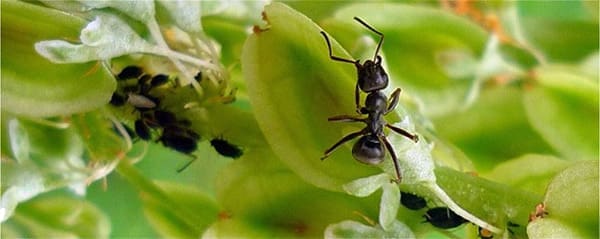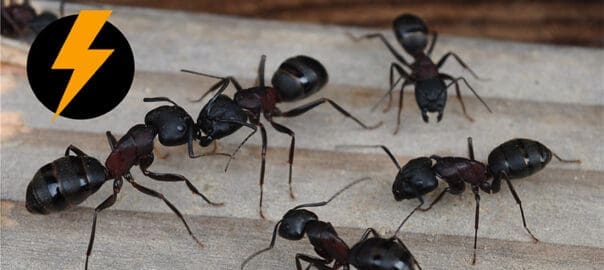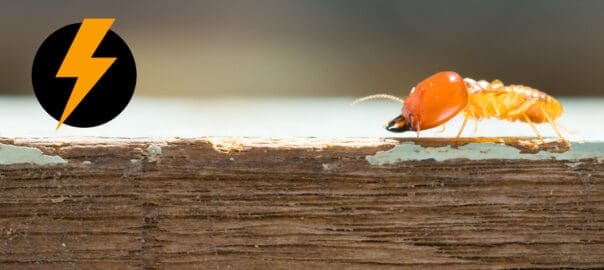Carpenter ants can cause dangerous and costly damage. Identifying carpenter ants and taking early preventative measures can go a long way in securing your home.
Ants: they’re not the ideal roommate, and you certainly don’t want to see them hovering around your pantry. But while some species of ants are more of an aesthetic nuisance, carpenter ants can do dangerous and costly damage to your home. Thankfully, there are key steps you can take to identify carpenter ants and to prevent them from taking up residence in your house.
Meet The Carpenter Ant
The Pacific Northwest is home to nearly a dozen species of carpenter ant – talk about the stuff of nightmares – but, thankfully, most can be treated in the same manner. The black carpenter ant, Camponotus pennsylvanicus, is the most common type of carpenter ant found in residences across the country. However, in the Pacific Northwest, you’re most likely to encounter C. modoc, one of the larger species of carpenter ants. And when these little guys make their way into your home, they can do pretty significant damage.
Read More: Ant And Termite Identification
Tiny Pests, Big Impact
While carpenter ants don’t pose much of a health risk to humans, and aren’t known to be common disease vectors, they can be unsightly, ruin food sources, and cause serious damage to structures. An infestation to crucial support beams, joists, and flooring can undermine the structural stability of your home, and could cause major problems if the ants are left to proliferate. And because carpenter ants grow their nest as their colony expands, carpenter ant infestations can be quite extensive, with extermination and repair being both costly and difficult. Thankfully, knowing how to identify carpenter ants and implement preventative measures can go a long way in preventing these pests from taking up residence in your home.

Too Much Of A Wood Thing
As you might have guessed based on their name, the favored building material of carpenter ants is wood. In particular, carpenter ants prefer dead, damp wood, as moisture and high humidity is crucial for the survival of eggs – and, therefore, the growth of the colony. And because damp wood is also easier to chew through, high-moisture areas of your home could quickly become a nest for carpenter ants.
Tunneling Through Your Home
Although wood is not a food source for carpenter ants, it is an excellent building material for their tunnels and galleries. Carpenter ants tunnel through wood with their strong mandibles, and at certain points within the tunnel system, they construct large galleries – open spaces and rooms. These galleries function as space for storing materials, wood dust, and even personnel, and can also serve as separate entrances to the nest. And while carpenter ants prefer to nest in trees, your house can also be an excellent place for them to colonize. Thankfully, there are some steps you can take to prevent carpenter ants from taking up residence in your home.

Contact vegetation is the most common method of entry for carpenter ants.
Entry Methods Of Carpenter Ants
Carpenter ants can enter your house in many ways, including through contact vegetation or gardening materials. Thankfully, there are a few ways you can reduce the likelihood of carpenter ants making their way into your home.
Contact Vegetation
Contact vegetation is the most common method of entry for carpenter ants. Contact vegetation includes shrubs, branches, and other plants that make physical contact with your home. For example, carpenter ants might use climbing vegetation, like ivy, to make their way into a structure. Eliminating the contact vegetation is a good preventative step – and don’t limit removal to the ground-level perimeter. Make sure you remove contact vegetation at your upper walls, eaves, and roof as well.
Catching A Ride
Sometimes, carpenter ants can be brought into your house via materials, including:
- Gardening woods, like bark and mulch
- Raw, untreated building materials
- Firewood
- Landscaping turf
- Transplanted trees or large shrubs
Since all of these entry methods will keep ants close to a food source – like outside vegetation or a food source within your home – carpenter ants could very easily remain in your house for an extended stay. Inspecting materials prior to installation is a good idea, and can help prevent a possible infestation.

Prevention Tips
There are some key steps you can take to make your home unappealing to carpenter ants. Like us, carpenter ants need a source of food and water, and because of their preference for damp wood, they prefer to nest in moist areas. A general sanitation plan, combined with moisture reduction, can be quite effective at reducing the desirability of your home for carpenter ants. Some key steps to basic sanitation and moisture control include:
- Put food away: Make sure grains, sugary foods, and especially pet foods are kept in sealed containers far from suspected entry points.
- Reduce moisture levels: Carpenter ants are often discovered in bathrooms and kitchens, so ensure any available water sources are tidied and managed closely. This can involve drying out moist cabinets, or keeping an eye on pet food and water dishes.
- Stop any leaks: Roof and plumbing leaks are common water sources for carpenter ants, so repairing these is a crucial step in preventing them from taking up residence in your home.
Carpenter ants can cause a great amount of damage to your home. By taking a few preventative steps, you can make your home a less desirable place for them to take up residence.

Call In The Experts
Early preventative measures can go a long way in ant-proofing your home. But if you’re already seeing carpenter ants in or around your house, contact us today to schedule an inspection. We’re here to help, and we offer a 100% guarantee on all of our services.
If you need an inspection to determine if you have bed bugs or carpet beetles contact us or give us a call to talk with our friendly and knowledgeable staff.
5 Star Pest Control Service available in Albany, Ashland, Corvallis, Eugene, Grants Pass, McMinnville, Medford, Newberg, Roseburg, Salem, Sherwood, Wilsonville, Woodburn, Tigard, Tualatin and surrounding areas.



 Termites in Oregon: Are Termites a Problem in Oregon?
Termites in Oregon: Are Termites a Problem in Oregon? Termites in Oregon: Are Termites a Problem in Oregon?
Termites in Oregon: Are Termites a Problem in Oregon? All About German Cockroaches
All About German Cockroaches How to Get Rid of Ants
How to Get Rid of Ants Why Indoor Pest Treatment?
Why Indoor Pest Treatment?